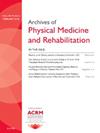在肘关节骨折康复中,双任务阻力训练比单独的阻力训练更能提高力量和减轻疼痛:一项随机对照试验。
IF 3.7
2区 医学
Q1 REHABILITATION
Archives of physical medicine and rehabilitation
Pub Date : 2025-08-01
DOI:10.1016/j.apmr.2025.01.419
引用次数: 0
摘要
目的:探讨为期12周的双任务阻力运动对肘部骨折康复患者力量、疼痛强度、活动范围(ROM)和功能的影响。设计:随机对照试验设置:康复医院。参与者:接受肘部骨折康复治疗的个体。干预:使用编号信封按顺序进行随机化,信封中包含分配给干预组(使用自我调节的数学任务进行双任务阻力训练,n=18)或对照组(传统阻力训练,n=14),为期12周。主要结果:测量:主要结果是肘关节屈伸肌的肌力和疼痛,通过视觉模拟量表从0到100 mm进行评估。次要结果为坦帕量表-11评估运动恐惧症,使用手臂、肩膀和手的残疾(DASH)问卷和被动rom评估残疾。结果:双任务阻力训练比单独的阻力训练更能提高力量和减轻疼痛(p0.05)。失能组与被动ROM组间差异无统计学意义(p < 0.05)。结论:双任务阻力训练与传统阻力训练在肘关节骨折康复12周后均能增强力量、减轻疼痛、改善功能、增加ROM。然而,双任务抗阻训练在增强力量和减轻疼痛方面优于单独抗阻训练。本文章由计算机程序翻译,如有差异,请以英文原文为准。
Dual-Task Resistance Training Improves Strength and Reduces Pain More Than Resistance Exercise Alone in Elbow Fracture Rehabilitation: A Randomized Controlled Trial
Objective
To examine the effects on strength, pain intensity, range of motion (ROM), and functionality of a 12-week dual-task resistance exercise program in patients undergoing rehabilitation from elbow fractures.
Design
Randomized controlled trial.
Setting
Rehabilitation hospital.
Participants
Individuals undergoing elbow fracture rehabilitation (N=32).
Intervention
Randomization was performed sequentially using numbered envelopes containing assignments to either an intervention group (dual-task resistance training using a mathematical task with self-regulation, N=18) or a control group (traditional resistance training, N=14) for 12 weeks.
Main Outcome Measures
The primary outcomes were muscle strength for elbow flexors and extensors and pain assessed by the visual analog scale from 0 to 100 mm. The secondary outcomes were kinesiophobia assessed by the Tampa Scale-11 and disability using the Disabilities of the Arm, Shoulder, and Hand questionnaire and passive ROM.
Results
Dual-task resistance training improved strength and reduced pain more than resistance training alone (P<.05), and only the dual-task group improved in kinesiophobia (P<.05). The linear regression showed a significant negative association between kinesiophobia and increased elbow strength in the dual-task group (flexion, r=−0.53, P=.024; extension, r=−0.65, P=.004) but not in the control group (P>.05). No significant differences were observed between the group for disability and passive ROM (P>.05).
Conclusions
Dual-task resistance training and traditional resistance training both enhance strength, reduce pain, improve functionality, and increase ROM after 12 weeks of elbow fracture rehabilitation. However, dual-task resistance training is superior to resistance training alone in enhancing strength and reducing pain.
求助全文
通过发布文献求助,成功后即可免费获取论文全文。
去求助
来源期刊
CiteScore
6.20
自引率
4.70%
发文量
495
审稿时长
38 days
期刊介绍:
The Archives of Physical Medicine and Rehabilitation publishes original, peer-reviewed research and clinical reports on important trends and developments in physical medicine and rehabilitation and related fields. This international journal brings researchers and clinicians authoritative information on the therapeutic utilization of physical, behavioral and pharmaceutical agents in providing comprehensive care for individuals with chronic illness and disabilities.
Archives began publication in 1920, publishes monthly, and is the official journal of the American Congress of Rehabilitation Medicine. Its papers are cited more often than any other rehabilitation journal.

 求助内容:
求助内容: 应助结果提醒方式:
应助结果提醒方式:


